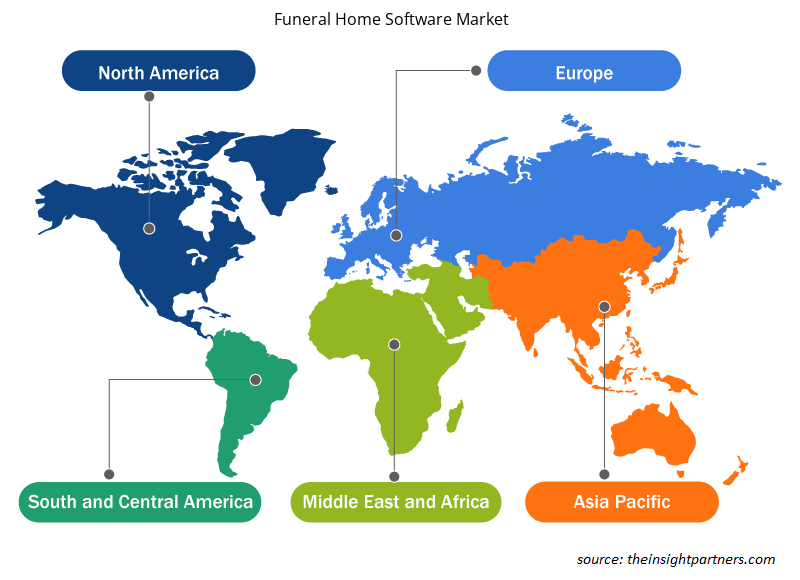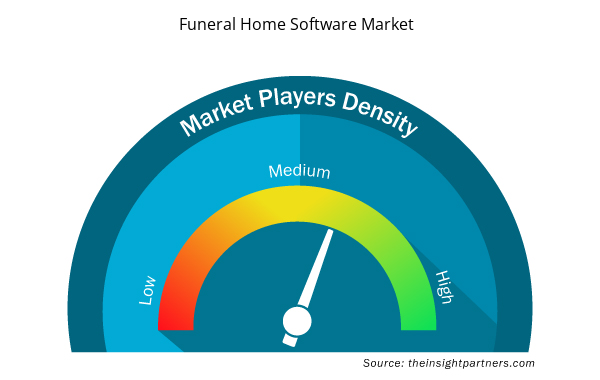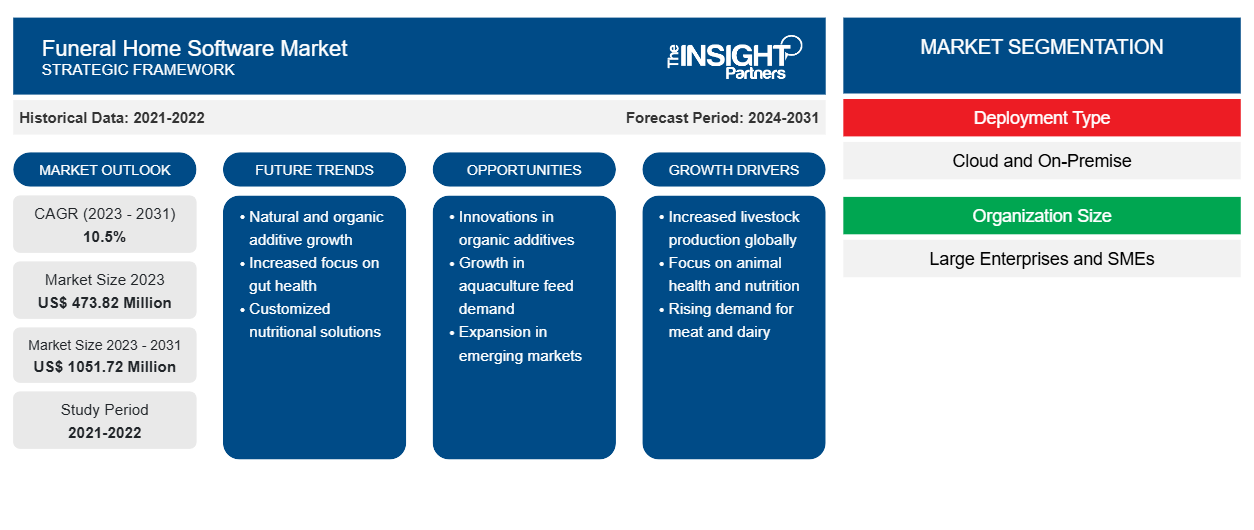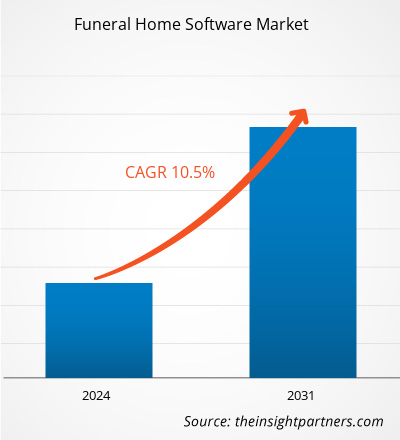Si prevede che la dimensione del mercato del software per pompe funebri raggiungerà i 1051,72 milioni di dollari entro il 2031, rispetto ai 473,82 milioni di dollari del 2023. Si prevede che il mercato registrerà un CAGR del 10,5% nel 2023-2031. La crescita della digitalizzazione e i vantaggi offerti dal software per pompe funebri rimarranno probabilmente le tendenze chiave del mercato del software per pompe funebri.
Analisi di mercato del software per le pompe funebri
L'aumento del numero di decessi porta alla crescita del mercato. La digitalizzazione nelle operazioni aziendali in tutto il mondo ha guadagnato terreno, il che ha ulteriormente portato all'adozione di soluzioni software per le pompe funebri. I vantaggi offerti dal software per le pompe funebri, come la facile gestione dei documenti, il servizio clienti migliorato, la contabilità automatizzata e altri, ne alimentano la domanda tra le pompe funebri per operazioni più rapide ed efficienti. Gli operatori e i gestori delle pompe funebri possono organizzare funerali e interagire con i clienti utilizzando il software per le pompe funebri. Gli operatori delle pompe funebri possono utilizzare soluzioni software per gestire la pianificazione, le risorse e i servizi personalizzati. Spesso, il programma offre un portale in cui i clienti possono inviare richieste di servizio e condividere informazioni sul defunto.
Panoramica del mercato del software per pompe funebri
Il software per pompe funebri aiuta pompe funebri, obitori e crematori a gestire e gestire tutti gli aspetti delle operazioni quotidiane. Automatizza la contabilità, l'inventario e la gestione dei documenti. Il software per pompe funebri fornisce il controllo completo sulle attività di back-office. Le funzionalità di front-office consentono di gestire i servizi funebri, condividere e firmare la documentazione e condividere merce e memoriali sul sito Web o sui social media.
Personalizza questo report in base alle tue esigenze
Riceverai la personalizzazione gratuita di qualsiasi report, comprese parti di questo report, o analisi a livello nazionale, pacchetto dati Excel, oltre a usufruire di grandi offerte e sconti per start-up e università
- Scopri le principali tendenze di mercato in questo rapporto.Questo campione GRATUITO includerà analisi di dati che spaziano dalle tendenze di mercato alle stime e alle previsioni.
Driver e opportunità del mercato del software per le pompe funebri
Digitalizzazione per favorire il mercato
C'è un aumento della digitalizzazione in tutto il mondo. La digitalizzazione per trasformare il modello di business, le operazioni e l'esperienza del cliente. Pertanto, la digitalizzazione nel settore funebre aiuta ad automatizzare il processo funebre. La digitalizzazione delle pompe funebri porta efficienza nell'intera gestione delle pompe funebri. Con l'aiuto del software, i clienti possono firmare digitalmente la documentazione richiesta senza dover essere fisicamente presenti. Il software per pompe funebri aiuta i fornitori di servizi di pompe funebri a organizzare l'assunzione, i tempi di consegna, i programmi di servizio e gli inviti. Ciò facilita un'esperienza positiva per i loro clienti durante un periodo difficile. I documenti, come i certificati commemorativi o i certificati di morte, possono essere importati e archiviati digitalmente. Queste piattaforme offrono risorse per l'archiviazione dei dati sulle disposizioni funebri e sui defunti. Con l'aiuto del software per pompe funebri, l'operatore della pompe funebri può aiutare gli utenti a pianificare i servizi imminenti e a creare un registro dei servizi passati. Molti hanno i mezzi per acquistare fiori, immagini e altri elementi personalizzati per i servizi. Alcuni sono anche dotati di strumenti per il controllo dei registri funebri. I report possono essere creati da diversi programmi software per pompe funebri e inviati al software di gestione del database o di contabilità.
Aumento dei decessi in tutto il mondo: un’opportunità nel mercato del software per le pompe funebri
Con il cambiamento dello stile di vita e delle abitudini alimentari, si registra un aumento delle malattie cardiovascolari (CVD) in tutto il mondo. Fattori come l'inquinamento atmosferico, l'ipertensione, il consumo di tabacco e il colesterolo elevato sono alcuni dei fattori che portano all'aumento del numero di decessi. Ad esempio, secondo la World Heart Federation (WHF), i decessi per CVD sono balzati a livello globale da 12,1 milioni nel 1990 a 20,5 milioni nel 2021. Il World Heart Report è stato lanciato al World Heart Summit del 2023. Pertanto, l'aumento dei decessi per motivi specifici ha portato a un aumento delle operazioni nell'agenzia funebre. L'adozione di software per agenzie funebri aiuterà i fornitori di servizi di pompe funebri a gestire in modo efficiente le operazioni funebri. Pertanto, l'aumento dei decessi funge da opportunità per la crescita del mercato in quanto incoraggerà il fornitore di servizi di pompe funebri ad adottare soluzioni per gestire efficacemente il processo e la documentazione.
Analisi della segmentazione del rapporto di mercato del software per pompe funebri
I segmenti chiave che hanno contribuito alla derivazione dell'analisi di mercato del software per le pompe funebri sono il tipo di prodotto e l'applicazione.
- In base al componente, il mercato è diviso in software e servizi. Il segmento software ha detenuto una quota di mercato maggiore nel 2023.
- Per distribuzione, il mercato è segmentato in cloud e on-premise. Il segmento on-premise ha detenuto la quota maggiore del mercato nel 2023.
- In base alle dimensioni aziendali, il mercato è segmentato in PMI e grandi imprese. Il segmento delle grandi imprese deteneva la quota maggiore del mercato nel 2023.
Analisi della quota di mercato del software per pompe funebri per area geografica
L'ambito geografico del rapporto sul mercato dei software per le pompe funebri è suddiviso principalmente in cinque regioni: Nord America, Asia Pacifico, Europa, Medio Oriente e Africa e Sud America/Sud e Centro America.
In termini di fatturato, il Nord America ha rappresentato la quota di mercato più grande per il software per le pompe funebri. Stati Uniti, Canada e Messico sono tra i paesi chiave del Nord America. La regione è una delle prime ad adottare soluzioni tecnologicamente avanzate, che è uno dei fattori chiave che guidano la crescita del mercato. I player del mercato del software per le pompe funebri della regione, che includono Aldor Solutions, FuneralTech, Lytesoft e molti altri, promuovono la quota di mercato della regione.
Approfondimenti regionali sul mercato del software per pompe funebri
Le tendenze regionali e i fattori che influenzano il mercato del software per le pompe funebri durante il periodo di previsione sono stati ampiamente spiegati dagli analisti di Insight Partners. Questa sezione discute anche i segmenti e la geografia del mercato del software per le pompe funebri in Nord America, Europa, Asia Pacifico, Medio Oriente e Africa e Sud e Centro America.

- Ottieni i dati specifici regionali per il mercato del software per pompe funebri
Ambito del rapporto di mercato del software per pompe funebri
| Attributo del report | Dettagli |
|---|---|
| Dimensioni del mercato nel 2023 | 473,82 milioni di dollari USA |
| Dimensioni del mercato entro il 2031 | 1051,72 milioni di dollari USA |
| CAGR globale (2023-2031) | 10,5% |
| Dati storici | 2021-2022 |
| Periodo di previsione | 2024-2031 |
| Segmenti coperti | Per tipo di distribuzione
|
| Regioni e Paesi coperti | America del Nord
|
| Leader di mercato e profili aziendali chiave |
|
Densità dei player del mercato del software per pompe funebri: comprendere il suo impatto sulle dinamiche aziendali
Il mercato del software per le pompe funebri sta crescendo rapidamente, spinto dalla crescente domanda degli utenti finali dovuta a fattori quali l'evoluzione delle preferenze dei consumatori, i progressi tecnologici e una maggiore consapevolezza dei vantaggi del prodotto. Con l'aumento della domanda, le aziende stanno ampliando le loro offerte, innovando per soddisfare le esigenze dei consumatori e capitalizzando sulle tendenze emergenti, il che alimenta ulteriormente la crescita del mercato.
La densità degli operatori di mercato si riferisce alla distribuzione di aziende o società che operano in un particolare mercato o settore. Indica quanti concorrenti (operatori di mercato) sono presenti in un dato spazio di mercato in relazione alle sue dimensioni o al valore di mercato totale.
Le principali aziende che operano nel mercato del software per le pompe funebri sono:
- N / A
Disclaimer : le aziende elencate sopra non sono classificate secondo un ordine particolare.

- Ottieni la panoramica dei principali attori del mercato dei software per pompe funebri
Notizie e sviluppi recenti sul mercato del software per pompe funebri
Il mercato del software per pompe funebri viene valutato raccogliendo dati qualitativi e quantitativi dopo la ricerca primaria e secondaria, che include importanti pubblicazioni aziendali, dati associativi e database. Di seguito è riportato un elenco degli sviluppi nel mercato:
- A marzo 2022, CTV Software Pty Ltd. ha annunciato Funeral Buddy 6.0 con nuove funzionalità. Le sue nuove funzionalità per le filiali, l'accesso alla famiglia e altri miglioramenti migliorano la gestione complessiva dell'agenzia di pompe funebri. Con la funzionalità aggiuntiva, la famiglia ottiene le credenziali di accesso e ha un rapido accesso ai documenti di trasferimento. (Fonte: CTV Software Pty Ltd., Comunicato stampa, 2022)
- A marzo 2023, Strategic Funeral Resources (SFR) ha introdotto quattro programmi pubblicitari sui social media a prezzi ragionevoli per aiutare i fornitori di servizi funebri ad aumentare il coinvolgimento dei consumatori e aumentare la redditività. Ogni programma è disponibile in uno dei due pacchetti (standard e preferito) e molti offrono eccezionali funzionalità di personalizzazione. I pacchetti integrano il suo software di intelligenza artificiale proprietario Automated Virtual Arranger (AVA). Digitalizzando il proprietario dell'agenzia di pompe funebri o un membro dello staff, il processo AVA prende i migliori tipi di interazioni umane (connessioni coinvolgenti, calorose ed emozionali) e li combina con la rivoluzionaria tecnologia AI per creare un'esperienza di visualizzazione dei contenuti realistica per il pubblico di destinazione di un'azienda. (Fonte: National Funeral Directors Association, comunicato stampa, 2023)
Copertura e risultati del rapporto sul mercato del software per pompe funebri
Il rapporto "Dimensioni e previsioni del mercato del software per pompe funebri (2021-2031)" fornisce un'analisi dettagliata del mercato che copre le seguenti aree:
- Dimensioni e previsioni del mercato a livello globale, regionale e nazionale per tutti i segmenti di mercato chiave coperti dall'ambito
- Dinamiche di mercato come fattori trainanti, vincoli e opportunità chiave
- Principali tendenze future
- Analisi dettagliata delle cinque forze PEST/Porter e SWOT
- Analisi di mercato globale e regionale che copre le principali tendenze di mercato, i principali attori, le normative e gli sviluppi recenti del mercato
- Analisi del panorama industriale e della concorrenza che copre la concentrazione del mercato, l'analisi della mappa di calore, i principali attori e gli sviluppi recenti
- Profili aziendali dettagliati
- Analisi storica (2 anni), anno base, previsione (7 anni) con CAGR
- Analisi PEST e SWOT
- Valore/volume delle dimensioni del mercato - Globale, regionale, nazionale
- Industria e panorama competitivo
- Set di dati Excel


- Enzymatic DNA Synthesis Market
- Redistribution Layer Material Market
- Intradermal Injection Market
- Queue Management System Market
- Passport Reader Market
- Identity Verification Market
- Europe Tortilla Market
- Nuclear Waste Management System Market
- Animal Genetics Market
- Electronic Toll Collection System Market

Report Coverage
Revenue forecast, Company Analysis, Industry landscape, Growth factors, and Trends

Segment Covered
This text is related
to segments covered.

Regional Scope
North America, Europe, Asia Pacific, Middle East & Africa, South & Central America

Country Scope
This text is related
to country scope.
Domande frequenti
The global funeral home software market was estimated to be US$ 473.82 million in 2023 and is expected to grow at a CAGR of 10.5% during the period 2023 – 2031.
The rising deaths and digitalization in the funeral industry are the major factors that propel the global funeral home software market.
The adoption of advanced technology, such as machine learning (ML) and artificial intelligence (AI), is anticipated to play a significant role in the global funeral home software market in the coming years.
The key players holding majority shares in the global funeral home software market are Aldor Solutions, Tribute Technology, CTV Software Pty Ltd, FuneralTech, and Osiris Software.
The incremental growth expected to be recorded for the global funeral home software market during the forecast period is US$ 577.90 million.
The global funeral home software market is expected to reach US$ 1051.72 million by 2031.
Trends and growth analysis reports related to Technology, Media and Telecommunications : READ MORE..
The Insight Partners performs research in 4 major stages: Data Collection & Secondary Research, Primary Research, Data Analysis and Data Triangulation & Final Review.
- Data Collection and Secondary Research:
As a market research and consulting firm operating from a decade, we have published and advised several client across the globe. First step for any study will start with an assessment of currently available data and insights from existing reports. Further, historical and current market information is collected from Investor Presentations, Annual Reports, SEC Filings, etc., and other information related to company’s performance and market positioning are gathered from Paid Databases (Factiva, Hoovers, and Reuters) and various other publications available in public domain.
Several associations trade associates, technical forums, institutes, societies and organization are accessed to gain technical as well as market related insights through their publications such as research papers, blogs and press releases related to the studies are referred to get cues about the market. Further, white papers, journals, magazines, and other news articles published in last 3 years are scrutinized and analyzed to understand the current market trends.
- Primary Research:
The primarily interview analysis comprise of data obtained from industry participants interview and answers to survey questions gathered by in-house primary team.
For primary research, interviews are conducted with industry experts/CEOs/Marketing Managers/VPs/Subject Matter Experts from both demand and supply side to get a 360-degree view of the market. The primary team conducts several interviews based on the complexity of the markets to understand the various market trends and dynamics which makes research more credible and precise.
A typical research interview fulfils the following functions:
- Provides first-hand information on the market size, market trends, growth trends, competitive landscape, and outlook
- Validates and strengthens in-house secondary research findings
- Develops the analysis team’s expertise and market understanding
Primary research involves email interactions and telephone interviews for each market, category, segment, and sub-segment across geographies. The participants who typically take part in such a process include, but are not limited to:
- Industry participants: VPs, business development managers, market intelligence managers and national sales managers
- Outside experts: Valuation experts, research analysts and key opinion leaders specializing in the electronics and semiconductor industry.
Below is the breakup of our primary respondents by company, designation, and region:

Once we receive the confirmation from primary research sources or primary respondents, we finalize the base year market estimation and forecast the data as per the macroeconomic and microeconomic factors assessed during data collection.
- Data Analysis:
Once data is validated through both secondary as well as primary respondents, we finalize the market estimations by hypothesis formulation and factor analysis at regional and country level.
- Macro-Economic Factor Analysis:
We analyse macroeconomic indicators such the gross domestic product (GDP), increase in the demand for goods and services across industries, technological advancement, regional economic growth, governmental policies, the influence of COVID-19, PEST analysis, and other aspects. This analysis aids in setting benchmarks for various nations/regions and approximating market splits. Additionally, the general trend of the aforementioned components aid in determining the market's development possibilities.
- Country Level Data:
Various factors that are especially aligned to the country are taken into account to determine the market size for a certain area and country, including the presence of vendors, such as headquarters and offices, the country's GDP, demand patterns, and industry growth. To comprehend the market dynamics for the nation, a number of growth variables, inhibitors, application areas, and current market trends are researched. The aforementioned elements aid in determining the country's overall market's growth potential.
- Company Profile:
The “Table of Contents” is formulated by listing and analyzing more than 25 - 30 companies operating in the market ecosystem across geographies. However, we profile only 10 companies as a standard practice in our syndicate reports. These 10 companies comprise leading, emerging, and regional players. Nonetheless, our analysis is not restricted to the 10 listed companies, we also analyze other companies present in the market to develop a holistic view and understand the prevailing trends. The “Company Profiles” section in the report covers key facts, business description, products & services, financial information, SWOT analysis, and key developments. The financial information presented is extracted from the annual reports and official documents of the publicly listed companies. Upon collecting the information for the sections of respective companies, we verify them via various primary sources and then compile the data in respective company profiles. The company level information helps us in deriving the base number as well as in forecasting the market size.
- Developing Base Number:
Aggregation of sales statistics (2020-2022) and macro-economic factor, and other secondary and primary research insights are utilized to arrive at base number and related market shares for 2022. The data gaps are identified in this step and relevant market data is analyzed, collected from paid primary interviews or databases. On finalizing the base year market size, forecasts are developed on the basis of macro-economic, industry and market growth factors and company level analysis.
- Data Triangulation and Final Review:
The market findings and base year market size calculations are validated from supply as well as demand side. Demand side validations are based on macro-economic factor analysis and benchmarks for respective regions and countries. In case of supply side validations, revenues of major companies are estimated (in case not available) based on industry benchmark, approximate number of employees, product portfolio, and primary interviews revenues are gathered. Further revenue from target product/service segment is assessed to avoid overshooting of market statistics. In case of heavy deviations between supply and demand side values, all thes steps are repeated to achieve synchronization.
We follow an iterative model, wherein we share our research findings with Subject Matter Experts (SME’s) and Key Opinion Leaders (KOLs) until consensus view of the market is not formulated – this model negates any drastic deviation in the opinions of experts. Only validated and universally acceptable research findings are quoted in our reports.
We have important check points that we use to validate our research findings – which we call – data triangulation, where we validate the information, we generate from secondary sources with primary interviews and then we re-validate with our internal data bases and Subject matter experts. This comprehensive model enables us to deliver high quality, reliable data in shortest possible time.


 Ottieni un campione gratuito per questo repot
Ottieni un campione gratuito per questo repot